#women in war
Text

The American Women’s Voluntary Services began operations on January 4, 1942 at Sixth Avenue and 42nd Street. They ran a mobile kitchen serving hot drinks, doughnuts, and sandwiches to all men in uniform. This being the '40s, cigarettes were handed out, too. Some of the first “customers” are shown taking advantage of the free service.
Photo: Associated Press
#vintage New York#1940s#World War II#home front#Women's Voluntary Services#Jan. 4#4 Jan.#free lunch#women in war#civilians in World War II#AWVS#WVS
97 notes
·
View notes
Text


1. Wars are MAN-made.
2. Women have ALWAYS fought for their country and people, whether by taking care of their home environment & other civilians as much as possible or by actively joining combat, even if men didn’t approve of it and often punished them for it.
3. Women and children are the primary victims when it comes to war crimes such as rape, forced pregnancy, slavery … and they make up the majority of post-war deaths.
4. Women are not only targeted by the intruders, but also by THEIR OWN MALE PEERS.
Any man who whines and complains that "women have it so much better" quite frankly doesn’t deserve any sympathy, and IDGAF what happens to men like that. You either educate yourself, become an ally to women or you merely prove that you‘re expendable AT BEST.
#women deserve better#radfem#radblr#radical feminism#feminism#radfems do touch#radfems do interact#reblog#radfems please touch#womens rights#women in war
186 notes
·
View notes
Text

Women In War Jan 1959 (and Battle Cry Dec 1962)
Victor Prezio
#golden age art#pulp magazine art#pulp art#pulp art 1959#Women In War#Battle Cry#Vic Prezio art#byronrimbaud
118 notes
·
View notes
Text

Laura Knight
Ruby Loftus screwing a Breech-ring
1943
#laura knight#wwii#wwii era#wwii england#women at work#women in war#the home front#factory workers#women artists#women painters#war documentary#british artist#british art#modern art#art history#aesthetictumblr#tumblraesthetic#tumblrpic#tumblrpictures#wwii women#aesthetic#beautiful painting#ruby loftus
114 notes
·
View notes
Text







Women testing weapons at Aberdeen Proving Ground in Maryland, 1942.
Photographed by Bernard Hoffman and Myron Davis for the February 1, 1943 issue of LIFE Magazine.
"The women come from everywhere. Many have husbands in the Army. Others have husbands who also work at Aberdeen. They wear bright-colored slacks, and their ‘firing fronts’ are a rippling blend of pink, blue and orange, mixed with white and black powder from the guns. They serve on crews of all weapons up to the 90mm A.A.’s [anti-aircraft guns]. They handle highly technical instruments. They drive trucks, act as bicycle messengers, swab and clean vehicles."
#women#old photos#1940s#*#feminism#life magazine#bernard hoffman#myron davis#women in history#artillery#guns#wwii#wwii history#historic photographs#vintage#history#world war ii#women in war#40s#world war 2#photography#old photography#black and white photography#b&w photography#war photography#war history#b&w#black and white
20 notes
·
View notes
Text
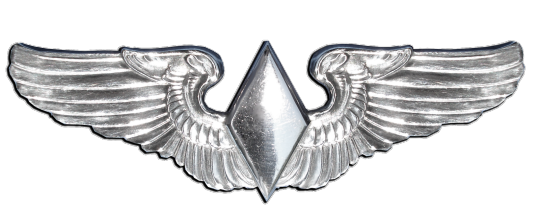
Insigne des Women Airforce Service Pilots (WASP)

Betty Gillies des Women Airforce Service Pilots (WASP) – 1943
©United States Air Force – 020927-O-9999A-004
Betty Gillies a été la première femme pilote à être «certifiée en vol» et a intégrer le Women's Auxiliary Ferring Squadron, plus tard le Women Airforce Service Pilots.
#WWII#united states army air forces#usaaf#unités#units#women airforce service pilots#wasp#femmes dans la guerre#women in war#betty gillies#1943
17 notes
·
View notes
Link
“In 1919 after the outbreak of the Polish-Soviet war Wanda ‘Kazik’ Gertz became the commander of the 2nd Women’s Volunteer Legion in the Polish army. The legion fought for Vilnius which led to Gertz being awarded the rank of lieutenant as well as the Virtuti Militari medal. She couldn’t enjoy her position for too long though, as in 1922 she lost her lieutenant rank due to the lack of law stating that a woman can be an officer in the Polish army. Afterwards, ‘Kazik’ worked in different fields for 17 years – she worked in an engineering company, in Józef Piłsudski’s office, in the management team of the Belweder Museum etc.
In World War II Gertz created a pseudonym for herself: ‘Lena’, and became one of the first women to join the resistance movement Service for Poland’s Victory. Soon after that, she made history as the first woman to create and command a fully female military unit – ‘DYSK’ unit (Women’s Diversion and Sabotage Unit) as a part of the Polish Home Army. In 1944 she was promoted to the rank of major.”
#history#women in history#wanda gertz#poland#polish history#first world war#second world war#Women in World War II#women in war#20th century#warriors#women's history#female soldiers
17 notes
·
View notes
Text
Nicola Trahan, who has died aged 97, joined the French resistance as a schoolgirl and was awarded the Croix de Guerre avec Palme for her bravery during “numerous dangerous missions”, in particular a series of battles between her Maquis and the notorious 2nd SS Panzerdivision Das Reich. After the second world war she settled in the UK, where she served with the Soldiers’, Sailors’ and Airmen’s Families Association (SSAFA) for 50 years.
Aged 16, while still at school in Valençay, Indre, in central France, she joined the Forces Françaises de l’Intérieur (FFI), the resistance organisation run by the Gaullist French authorities in London and known as the Armée Secrète.
According to her French military file, Trahan became a member of the North Indre Maquis, led by Francis Perdriset, a former French army officer who took charge of FFI resistance operations in that area in July 1943. Her main role was as a courier delivering messages twice daily between the various resistance teams.
She also worked as part of the Maquis’ medical team and, amid a heavy German military presence, used her trips cycling between the teams to collect intelligence. A note in a file has one resistance fighter telling another that Trahan would sometimes be late because she liked to sit by the road watching the Germans while eating her lunch. “Don’t worry,” he said. “It provides us with valuable information.”
In an interview with a French newspaper following the liberation of France, Trahan said that once when she was stopped by the Germans she screwed up her FFI identity pass into a ball and swallowed it to avoid arrest. She also recalled taking part in firefights and on one occasion shooting and wounding two German soldiers: “I really liked ambushes; when we put together a team and went off in full truckloads. I had a revolver and a machine gun.”
In July 1944, Perdriset and his Maquis began working closely with a British Special Operations Executive (SOE) officer Pearl Witherington (later Cornioley), who was also based in North Indre.
Witherington had set up the SOE’s Wrestler circuit in May that year. But on 11 June, five days after the D-day landings, she and the small number of resistance fighters she had assembled were attacked by a much larger German force. They fought them off but Witherington decided she needed an experienced military officer to help her to reorganise her forces.
“Finally, on 25 July [1944], after I had asked repeatedly for a military commander, to my great relief one arrived,” she recalled in her memoirs. “He was an army captain called Francis Perdriset.”
From that point on, the North Indre Maquis was closely integrated with the SOE Wrestler team. Trahan recalled meeting Witherington once, at a parachute drop of weapons and other supplies, where resistance members would have been called upon to remove the supplies to a safe location.
Shortly after Perdriset took over as Witherington’s military commander, elements of the German 2nd SS Panzerdivision Das Reich arrived in the region on their way north to Normandy, having been ordered to destroy the resistance along the way.
They had previously massacred an entire village at Oradour-sur-Glane and, from mid-August, launched a series of attacks against resistance groups in the Indre area, most notably in Valençay itself, where Perdriset was present.
“The Germans did a lot of damage in Valençay,” Witherington recalled. “I wasn’t there but Francis was. He was told to stand against a wall, he really thought he had had it. The Germans set fire to things, shot, killed. It wasn’t as bad as Oradour-sur-Glane but it wasn’t a pretty sight.”
In his recommendation for the award of the Croix de Guerre, Perdriset said Trahan, then only 17, “notably distinguished herself at Valençay from 20 to 30 August 1944 by bringing her commander valuable information which she gathered at the heart of enemy operations”.
Born Nicole in Berck-sur-Mer, in the Pas de Calais, she was the daughter of André Trahan, who worked in the insurance industry, and Jeanne (nee Bourzes), a professor of English.
Nicole initially boarded at the Collège Cévenol at Le Chambon-sur-Lignon in south-central France. She later recalled that her parents took her to the UK when the Germans occupied northern France in 1940, but by 1942 she was at Cours Guynemer, a private school in Valençay.
After the war, Trahan went to the Sorbonne to study philosophy but, having decided that it was not for her, she trained as a nurse at the Ecole d’Infirmières des Associations Diaconesses in Paris, and at Brighton General hospital, in East Sussex, qualifying in 1953. She subsequently worked as a health visitor in Cheshire. She anglicised her name from Nicole to Nicola and was naturalised British in 1957.
The following year she joined SSAFA, first as a member of its nursing service, then as a health visitor working with service families in Germany, Belgium and Hong Kong. Trahan served with the association for 30 years and after retirement continued to work for them as a volunteer for a further 20 years.
Trahan settled in Orcheston, Wiltshire, where she was also a volunteer at Salisbury Cathedral, and enjoyed swimming and walking her dog.
In 2005, she was invited to the unveiling by Queen Elizabeth II of the monument in Whitehall to The Women of World War II, followed by a lunch for female veterans at Buckingham Palace. In 2008 she was appointed MBE.
Nicola (Nicole) Marie Pauline Trahan, resistance fighter and nurse, born 21 December 1926; died 18 January 2024
12 notes
·
View notes
Note
It is so sad to think how these women passionately wanted to serve their nation only to be betrayed like that by their own people.
God is either dead or a misogynist
Patriotism is largely for maIes no woman is free or seen as a person of the land under a flag.
In regards to your ask though, my money is on both.
12 notes
·
View notes
Text
Happy Birthday US Navy!
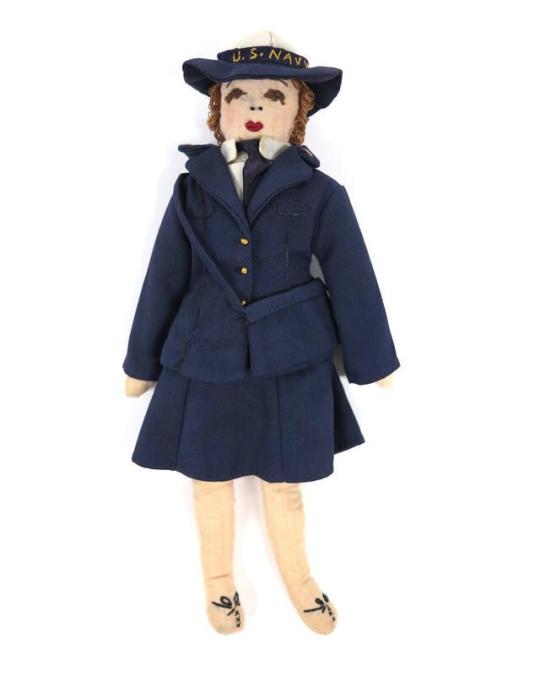
Happy 246th Birthday to the United States Navy!
The WAVES (Women Accepted for Volunteer Emergency Service) played an integral role in the Navy during WWII, taking on a wide range of duties from clerical work to aviation mechanics, aircraft navigation, and code breaking.
Ina McGee of Fitzgerald, GA, made this doll as a Christmas gift for Franklin Roosevelt. She sent it to the White House in December 1944: https://fdr.artifacts.archives.gov/objects/2991/wave-armed-service-doll
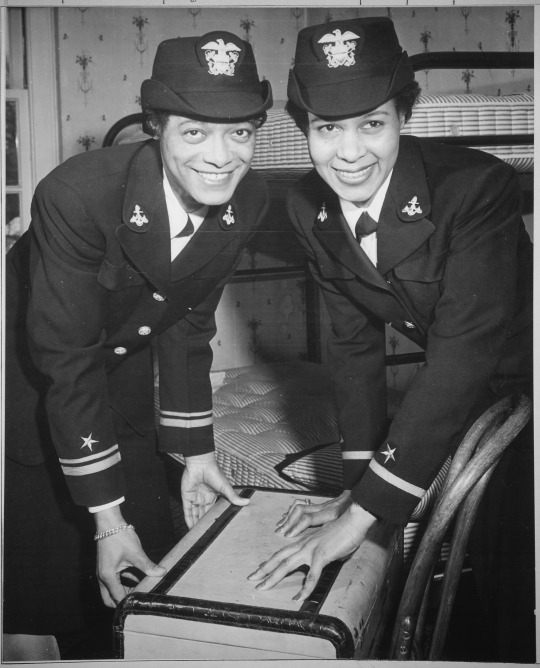
On December 26, 1944, Harriet Pickens and Frances Wills became the first female African American officers in the US Navy: https://catalog.archives.gov/id/520670
15 notes
·
View notes
Text
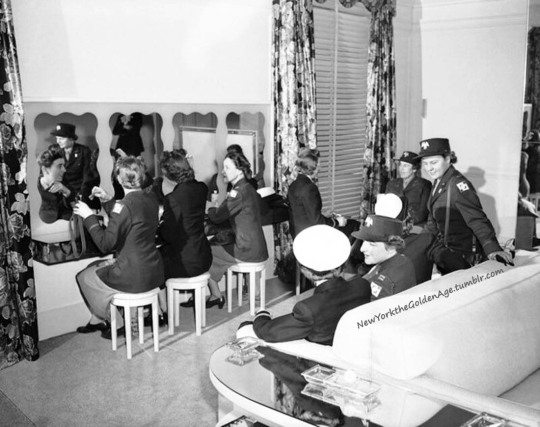
The old Whitelaw Reid mansion, where international society used to meet at banquets and balls, was used during World War II as the Women’s Military Services Club. Every member of the women’s auxiliaries of the Army, Navy, and Marine Corps and similar divisions of other Allies were welcome.
The mansion, which was designed by a member of Stanford White's staff, was built in 1882 and was converted into a club with overnight accommodations for about 50 enlisted women. It had shower and locker rooms, recreation and game rooms, lounges, writing rooms, a library, and a canteen where meals were served at cost. Girl Scouts served as waitresses. Members could entertain men in the lounges, and there were parties and weekly dances. This scene in the powder room shows officers of the WAACS, WAVES, and SPARS on April 25, 1943.
Photo: Robert Wands for the AP via Bloomberg
#vintage New York#1940s#Robert Wands#Bob Wands#World War II#women in war#military women#April 25#25 April#Women's Military Services Club#NYC in World War II
24 notes
·
View notes
Text

#vintage photography#black and white photography#ww1#world war one#nurse#nurses#women in war#women of ww1
27 notes
·
View notes
Photo
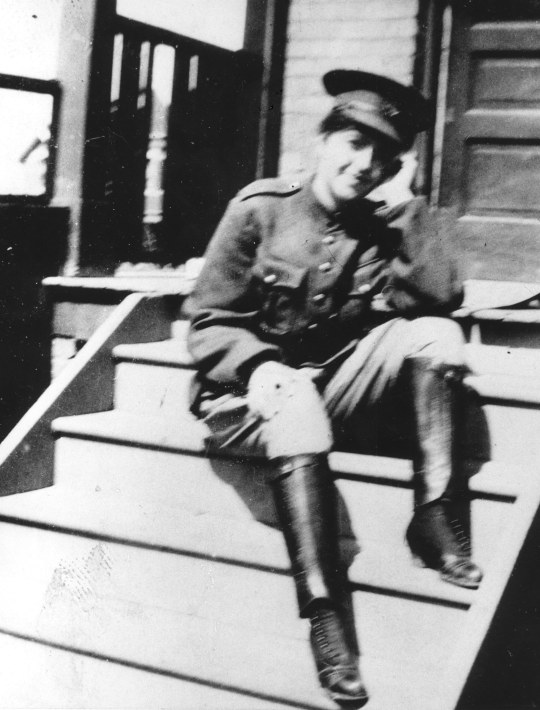
Photo of Mary Isabelle “Belle” McVeigh Fulcher, who is pictured wearing an CEF uniform in 1916, Edmonton Alberta. McVeigh herself would work in the war offices for the Canadian Medical Corps, as a telephone and stenographer operator.
#Women#Women in war#WWI#The First World War#world war 1#The great war#1914#1915#1916#1917#1918#1919#canadian history#canadian soldier#remembrance day#canada remembers#Alberta#ww1#ww1 stories#History#historical photos#world history#historical photography
28 notes
·
View notes
Text
This is why I hate it when men complain about how it’s unfair that they can just be sent into war. Women in war zones face rape, forced marriage and seeing their children die so men don’t want to go to war then stop causing them.
Abducted and enslaved by Boko Haram. Coerced into an abortion by soldiers. Two children dead. The ordeal of Aisha shows how women's lives have become a battlefield in the 13-year war between Islamist insurgents and the Nigerian military.
By LIBBY GEORGE and PAUL CARSTEN
Filed Dec. 14, 2022, 11 a.m. GMT
AISHA vividly recalls her family’s last time together. It was a pleasant evening in the summer of 2014, in her Nigerian village near the Cameroon border. The rainy season had nourished her father’s grain, pushing the stalks knee-high. Her father, mother, two brothers and a younger sister were all at home.
The village had been repeatedly attacked over months by armed Islamist insurgents seeking to expand their territory, she told Reuters. Aisha’s father had ordered the sons not to leave their house, lest they be caught up in the violence. That evening, their mother stepped outside to cook.
Gunfire erupted about 5 p.m. and continued for hours, Aisha said. Amid the shooting, her mother collapsed, struck in the chest by a stray round. Aisha, then 18, and her 14-year-old sister made frantic efforts to bandage the wound, but their mother bled out and died.
“My mother’s death is the first thing that pains me,” said Aisha, now 26, weeping quietly. By her account, that night marked the end of a secure childhood in a loving family – and the beginning of a hellish ordeal at the hands of both the Islamist militants and the Nigerian military, who have been locked in a 13-year war over control of the country’s northeast.
That war is being carried out, in part, upon the bodies of women and children. Thousands of women and girls have been kidnapped and forced into sexual slavery by Boko Haram and its Islamic State offshoot. The Nigerian military has responded to insurgents’ brutality with brutal tactics of its own, as revealed in two recent Reuters investigations.
Citing witness accounts and documents, the news agency reported on Dec. 7 that the army has run a secret abortion programme in the northeast, ending the pregnancies of thousands of women and girls freed from insurgent captivity. On Dec. 12, again citing dozens of witnesses, Reuters reported the army has intentionally killed children in the war, under a presumption they were, or would become, terrorists.
Nigerian military leaders told Reuters the abortion programme did not exist and said children were never targeted for killing in the war. They said the Reuters reporting is part of a foreign effort to undermine the country’s fight against the insurgents.
Aisha’s ordeal encompasses some of the most extreme hardships the war has inflicted upon civilians: enslavement by Boko Haram, forced abortion by the military, the loss of one child in a military bombing and another, she suspects, to poisoning by soldiers. The war also took the life of a brother, in addition to her mother, and all but destroyed one of her arms, Aisha said.
Dozens of women in northeast Nigeria told Reuters of similarly wrenching experiences during the ongoing strife, which has claimed more than 300,000 lives, including those of civilians killed by violence, starvation and disease. Like Aisha, they said they chose no sides in the war but were targeted by both.
Reuters could not reach representatives of Boko Haram or its offshoot, Islamic State West Africa Province, for comment.
Major General Christopher Musa, who leads the Nigerian counterinsurgency forces, said Aisha’s story, as described to him by Reuters, could not have happened. “No,” he said, “not by us, not by Nigerian Army troops, who don't have any reason to do that.”
Aisha spoke to Reuters on condition that only her Muslim name be used, citing fear for her safety. Reuters is not naming her village, as well, to protect her identity. Her story was corroborated in part by her sister; a friend and fellow captive; one of her brothers; and a neighbour. Each said they witnessed some of the events or heard about them afterward from Aisha. These people spoke on condition they not be fully named.
Aisha related her experiences in interviews over the course of more than a year, often speaking in a numbed monotone, occasionally breaking down.
“I saw it, exactly, with my own eyes, and I heard,” she said. “That’s why I don’t have any hesitation to share with you my account.”
Aisha smiled as she recalled her younger days, when she would pound, roll and fry “kuli kuli,” a peanut treat she sold with her mother at the market near their farm. Her family was sustained both by her mother’s work and her father’s cultivation of maize, guinea corn and millet.
“They showed me the way to look after myself, to seek out knowledge, how to be in and to live in the world,” she said of her parents. “We had everything we needed, really.”
Unlike some fathers in the region, she said, hers had made a priority of securing an education for his girls, and he never beat them. In high school, Aisha had a boyfriend in a neighbouring village whom she hoped to marry. She said she dreamt of becoming a soldier, an accountant or even a doctor – a secure livelihood in the economically depressed region. She hoped one day to have children.
But after the 2014 attack, school was out of the question: She was trapped in Boko Haram’s then-spreading caliphate.
At first, she said, the insurgents didn’t show “any signs that they were going to kill people.”
But after the attack that killed her mother, they started to kill the adult men in the village, she said. One brother vanished; she heard later that he died. Another brother fled elsewhere in Nigeria and survived. A third brother had already sought safety in Cameroon before their mother was killed.
RELATED CONTENT
U.S. State Department 'deeply troubled' by report on Nigerian army killing children
U.N. secretary-general calls on Nigeria to investigate report of forced abortions
Hungry and malnourished, northeast Nigeria endures humanitarian crisis
Aisha and her younger sister stayed with their father, who told them not to leave. At first, Boko Haram did not disturb villagers in their homes.
But by October 2014, the militants were enforcing extreme sharia law in her village, Aisha said. The fighters interrogated a well-known local midwife and herbalist, whom they accused of witchcraft. The insurgents took the woman, in her 50s, to the village square and, in front of as many people as they could gather, beheaded her with an axe. Aisha said she can’t forget the woman’s head and body dangling as blood spurted from her. She began to feel terrified.
Her father, who was in his 70s, fell ill, she said, and he died by the end of the year. Now the two young, unmarried sisters were living alone. Boko Haram men often came looking for them, knocking on their door and forcing them to hide.
For months, Aisha and her sister survived on the beans, maize and guinea corn that their father had stored. Then the food began to run out, and Aisha decided they should make a run for it.
Plotting her escape
They left their house in the middle of the day in search of any town nearby that was not controlled by insurgents. They hadn’t gone far when they ran into Islamist fighters.
The men forced Aisha and her sister into different open-bedded trucks, each filled with other women, she said. When the sisters were separated, “we both cried and pleaded to God,” she said, weeping.
The trucks arrived nearly a week later in Sambisa Forest, a massive woodland near the Cameroon border that served as a Boko Haram stronghold. Then her captors lined Aisha up alongside other women for militants to select as wives. One man, named Musa, pointed at Aisha.
“Suddenly you have a husband, you’ve become husband and wife, by force, without ever having seen each other,” she said.
Compelled to live with Musa inside the forest encampment, she tried to resist his advances, but her new husband repeatedly beat and raped her, and he threatened to kill her, she said. When he went off to fight in the war, she said, “I would pray to God that he’d be killed.”
Almost immediately, she was pregnant and sick nearly every day. Yet when her son, Bana, arrived, she could not help but love the boy. She longed to escape the brutality, hunger and fear that marked virtually every day of her captivity. But she did not believe she could do so with Bana, as boys were particularly valued in the Boko Haram community. She said she also feared a boy associated with the insurgents would face stigma outside Islamist-held territory, where he would be seen as a potential enemy.
“I just prayed, constantly, looking for a way to get out, to leave Sambisa behind,” she said.
As soon as she stopped breastfeeding Bana, she was pregnant again – and asked God for a daughter. The arrival of Fatima, a happy and amenable baby girl, steeled her determination to escape.
“For Bana…I didn’t let myself have hope for him,” she said. But Fatima, she said, “was a gift from God. I thought, if God allows for it, that girl will go to school.”
In the end, the Nigerian military decided Bana’s fate. One morning about four years ago, when he was roughly 3, the military launched an airstrike on the camp. They blew up the hut where the boy slept. Aisha, who was nearby, ran to save him but was too late.
“He cried out once, then again, and then he died,” she said.
The explosion also hit Aisha, burning her severely and leaving one arm nearly useless, she said. She showed a reporter the arm, which she typically keeps hidden under her flowing hijab. She cannot use it, even to hold a drink.
Aisha took months to recover after the bombing attack. Lying in the insurgent camp’s infirmary, she plotted her escape, intent on saving Fatima from a future of hunger and rape under the militants. By then, she had been in captivity for more than three years.
In 2019, with 1-year-old Fatima tied to her back, Aisha slipped from the camp in the middle of the night along with six other women and two young children besides her daughter. They zig-zagged through the wilderness for four days, trying to avoid detection.
On the fifth day, they found a group of Nigerian soldiers, identifying them by their boots. At long last, she thought, she and her daughter were safe.
No traces of her
The troops took the women and children to a nearby encampment in the town of Madagali – a cluster of five army tents and a thatched hut, she said. There, they underwent interrogation and medical check-ups. The soldiers took samples of their blood and urine.
The following day, they told Aisha she had a vaginal infection. They injected two vials of medicine into her buttocks, without telling her what it was, and gave her an assortment of pills, she said. An hour later, she said, she was in wrenching pain and began bleeding heavily from her vagina.
Eventually, she said, she saw blood and a lump of what looked like flesh pass from her body. She had not known she was pregnant.
She realised she had been tricked into an abortion, but was too afraid to confront the soldiers. They told her later that they had done her a favour, she recalled, because a child of Boko Haram would be ostracised and a burden on her and her community.
Aisha had not wanted another child from a Boko Haram father, she said, but abortion was against her Islamic faith.
art 1. The Abortion Assault
Part 2. Smothered, Poisoned and Shot
Several days later, soldiers said Fatima needed medicine to keep her strong after being so long in the wilderness. They gave her and other children injections. Afterward, the mothers and children were piled into cars and returned to their villages.
After their arrival at the family’s former home, within hours of the injections, Fatima started acting strangely, Aisha said.
She would not breastfeed, her eyes became distant and glassy, and she developed a fever. A local pharmacist told her the child must have been bitten by a bug and gave her a syrup to lower her temperature.
Before dawn, Fatima went cold. She died in the same room where Aisha watched her mother bleed out years earlier. Aisha believes that the girl was poisoned by the soldiers.
Later in the morning, neighbours who heard Aisha’s sobs came to help her bury the tiny body in the local cemetery. One neighbour, Musa, confirmed Aisha’s account of that episode, saying he saw the girl before she died, and saw Aisha grieving afterward.
After Fatima’s burial, Aisha had no traces left of her daughter. Phones were forbidden for women in the militant camp, so she had no pictures or videos. They had escaped only with the clothes they were wearing.
Some joy, many sorrows
With Fatima gone, Aisha was alone. She made her way to a displaced persons camp in the city of Yola, a crowded and chaotic place populated with many other women as traumatised as she was. There was little food, and no money.
In the camp, Aisha found a new friend, Felerin, who held her as she cried over her losses. Felerin had suffered, too, telling Reuters she’d had a forced abortion and lost two young sons after soldiers injected them with poison at Giwa Barracks in Maiduguri. She confirmed to Reuters that Aisha had confided in her about her ordeal.
Weeks later, Aisha’s sister found her at the camp. She had escaped from another part of Sambisa Forest. The young women screamed with joy, drawing a crowd of curious spectators.
She was so emaciated, “I barely recognized her,” Aisha’s sister told Reuters. “I didn’t think it was her.”
The sister, who said she’d been a servant to the wife of a high-ranking Boko Haram leader during her captivity, had not seen Aisha since their arrival in Sambisa Forest. After they reunited, she said, Aisha shared the details of her life during their time apart – including her escape, the abortion and the suspected poisoning of Fatima.
REUTERS INVESTIGATES
More Reuters investigations and long-form narratives
Got a confidential news tip? Reuters Investigates offers several ways to securely contact our reporters
After leaving the camp, Aisha and her sister stayed for a short time with an aunt in the Nigerian capital, Abuja, but she treated them as a burden, saying they had “the attitudes” of Boko Haram, Aisha said. The sisters have since settled in their former village together at their old house.
Aisha says her sister is a comfort and a link to her tranquil early years. Her sister has a daughter, now 2, who entertains them both.
But with her damaged right arm, Aisha cannot pound and mix kuli kuli to sell. She and her sister now sell fried groundnuts on the side of the road, earning barely enough to live.
Aisha mostly keeps her story to herself, and has avoided most old friends. She fears being called a “Boko Haram bride,” a slur thrown at many of the women who escaped captivity.
Still, Aisha feels compelled to pray for forgiveness – for failing to save her two children, for the sinful abortion and for the anger that won’t leave her. Until September, she used to fast twice a week in supplication to God, but she became too weak to continue.
She does not know if her life will improve.
“Who can truly know, if not God?” she asked. “But we pray to see things change, for the world to become better again, like it was before.”
15 notes
·
View notes
Text
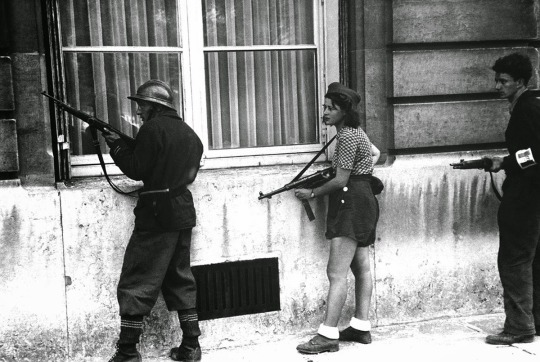
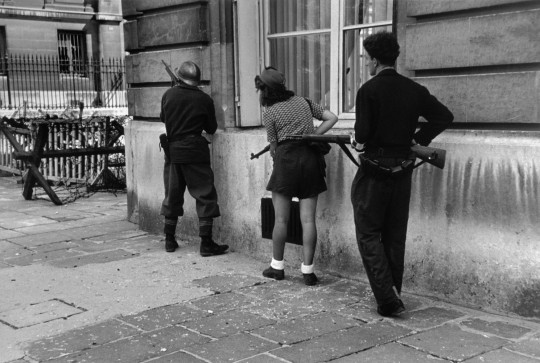
Après son entrée dans Paris avec les troupes de la 2e Division blindée, Simone Segouin, résistante française dans les Francs-tireurs et partisans (FTP), et deux de ses camarades participent à l'élimination des dernières poches de résistance – Libération de Paris – Opération Overlord – Août 1944
Photos Robert Capa
©Magnum photos
Simone Segouin rejoint les Francs-Tireurs et Partisans en 1944 à l'âge de 18 ans sous le pseudonyme de Nicole Minet. Après de nombreuses missions en tant qu'agent de liaison entre Dreux, Chartres et Châteaudun, les FTP lui propose de prendre les armes et devient l'une des rares femmes à prendre part aux combats. Attaques de convois, de trains, de détachements ennemis et opérations de sabotage lui valent le respect au sein de la résistance.
Elle participe activement à la libération de Chartres et s'illustre le 20 août 1944 en prenant part à la capture de 25 allemands à Thivars, à 7 km au sud de Chartres. A cette occasion elle récupère un pistolet mitrailleur MP40 avec lequel elle pose fièrement lors de la venue du Général de Gaulle à Chartres le 23 août pendant sa tournée d'inspection des régions libérées.
A la suite de cette cérémonie, les différents groupes de résistants du département prennent la direction de Paris pour participer aux combats insurrectionnels. La plupart regagnent Paris et font la jonction avec la 2e Division blindée de Leclerc le 25 août à six heures du matin.
C'est la raison pour laquelle, un cliché de Robert Capa présente Simone Segouin aux côtés de deux de ses camarades face aux dernières poches de résistance allemande.
Sa conduite valeureuse dans la clandestinité et son action dans les combats de la Libération lui valurent le grade de sous-lieutenant.
Elle fût décorée de la croix de guerre par Charles Tillon, ministre de l'Armement et ancien chef des FTP le 24 mars 1946 à Chartres.
#WWII#opération overlord#operation overlord#overlord#libération de la france#liberation of france#libération de paris#liberation of paris#résistance#resistance#résistance française#french resistance#francs-tireurs et partisans#ftp#femmes dans la guerre#women in war#figures historiques#historical figures#simone segouin#paris#france#août 1944
19 notes
·
View notes
Text
youtube
3 notes
·
View notes